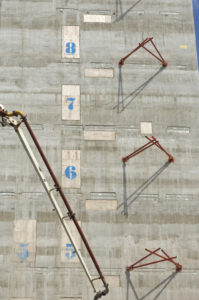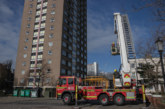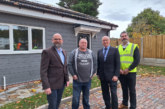Tony Jones discusses the need for a more holistic approach to safeguarding buildings and believes government could learn a lot from looking north of the border for fire safety guidance.
The Grenfell Tower tragedy laid bare the need for pressing action to ensure our Building Regulations are safe and fit for purpose. More than 18 months later, the extent and nature of the required changes are still a matter for debate.
It’s no secret that the construction industry is fragmented and driven by complex commercial drivers. While change is our collective responsibility, the competing interests at play mean that — like local authorities and registered providers — we are willing participants looking for government to take the lead on strengthening regulations. However, the differing approaches of Holyrood and Westminster are showing that there is no one pathway to delivering the reassurance residents and those responsible for their safety desperately need.

Northern appeal
The Scottish Parliament has devolved authority to legislate over building standards and regulations. In the wake of Grenfell, it was quick to exercise these powers, establishing two ministerial working groups to review the Scottish regulatory framework in June 2017.
Crucially, Holyrood launched its initial consultation on building standards in July 2018 — a month after the English and Welsh consultation on combustible cladding was launched, but arguably already ahead. The Scottish consultation was much broader in scope, covering not only cladding but also accountability for duty-holders, the provision of sprinklers and the proposal of a new ‘central hub’ to verify complex fire engineering solutions.
This approach conforms more closely to the holistic overhaul recommended by Dame Judith Hackitt in her independent review, who acknowledged that tackling combustible cladding in isolation will not fix our current system. A wider-reaching regulatory consultation for England and Wales is on its way but, disappointingly, not until this spring.
While the delay will give the Government more time to flesh out its Hackitt implementation plan, Building a Safer Future, changing legislation is inevitably a drawn out process. To limit uncertainty, it’s in everybody’s interests to kick-start this process as soon as possible.
Of course, we have already seen action to ban combustible cladding both north and south of the border. Again, Holyrood is planning to go further, with its consultation proposing to apply the ban to residential buildings over 11m in height compared to the 18m mandated for England. Why? The difference can partly be attributed to the Scottish review considering other tragic fires beyond Grenfell that have left their mark on the national consciousness.
In June 1999, a fire in North Ayrshire swept through a 14-storey block of flats, taking one life and injuring others, including children. The report of the Garnock Court incident cited that cladding was to blame for the rapid growth of the blaze. Accordingly, the Scottish Building Regulations introduced in 2005 specified that design and construction of external walls should ensure the spread of a fire is inhibited.
In the wake of Grenfell, regulations will be restricted further, but we should note that the Scottish Government’s consultation indicates that it is still proposing to allow the BS8414 fire performance test for external cladding as a route to compliance for combustible systems. This means that in certain circumstances where specific criteria are met, combustible cladding could still be used on new residential buildings above the limit specified in regulations. Given the current lack of public confidence, Holyrood might consider whether this is appropriate for the immediate future.

Addressing total risk
There is one particular area of the Scottish Technical Handbook that policymakers for England and Wales should look at closely. Tightened regulations following the North Ayrshire tragedy included a new provision to prevent the use of combustible structural elements, such as cross-laminated timber, for residential buildings above 18m where a more complex fire safety engineering assessment has not taken place.
As Hackitt acknowledges, structural safety plays an integral role in protecting residents and communities from the potential dangers of collapse. While the Government’s response states that it accepts the recommendation of Hackitt for ‘facilitating the prioritisation of fire and structural safety while encouraging a holistic approach that considers building safety objectives’, there is little evidence of structural safety being prioritised.
For instance, it has not been included as part of Westminster’s proposed review of current Approved Documents, the technical guidance that forms the foundation of our Building Regulations. This is despite the current advice in Approved Document B3 (1) stating ambiguously that a building’s stability must last for ‘a reasonable period’ in a fire.
The definition of ‘reasonable’ is vague and subject to several considerations, such as differing evacuation policies or specific uses where a high concentration of elderly residents, for example, may need more time to escape. This ambiguity is particularly concerning given the potential impact of structural failure on a building’s neighbours. Building Regulation 8 indicates designers are responsible for securing safety for ‘persons in or about’ a building, but more explicit guidance is needed to protect communities.
As it stands, there is no difference in Approved Document B structural fire resistance requirements whether a building is isolated or urban, despite the heightened implications of a collapse in a built-up environment. To eliminate complacency and deliver holistic change, enhancing structural safety by restricting combustible elements should be a priority for regulatory change, mirroring the progressive steps already taken in Scotland.
Beyond the technical merits of each system, the current disparate legislation on cladding and structure shows how, too often, our regulations are built by reacting to specific incidents rather than addressing all known risks. A reactive approach is not good enough.
Helping to restore faith in the construction industry and the local authorities and registered providers entrusted with communities’ wellbeing, needs a holistic approach safeguarding against all eventualities. Whether Holyrood or Westminster, this starts with government.
Tony Jones is Principal Structural Engineer at The Concrete Centre










